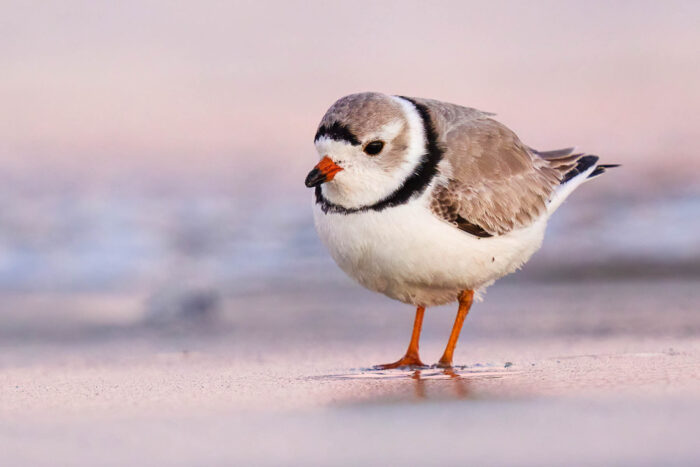Piping Plover
Charadrius melodus
Piping plover is a small, sand-colored bird that nests along the Atlantic Coast.
This section shows one large critter image at a time. Use the thumbnails that follow to select a specific image to display here.

This gallery contains a grid of small thumbnails. Selecting a thumbnail will change the main image in the preceding section.
Appearance
Piping plover is a small plover, about the size of a sparrow, with a very short bill. Its back is highly camouflaged with white sandy beaches. The bird had a white belly and thin legs that match the color of its beak.
Feeding
Piping plovers forage by running up and down the beach, pausing and pecking at the ground as they find food. The bird will sometimes stand on one foot and use the other foot to splash the water, which draws out crustaceans and worms for them to eat.
Piping plovers rely on storms to produce the right conditions for foraging. Heavy storms create “overwash” which is when sand gets deposited inland, covering up large areas of vegetation and producing moist, undisturbed areas for foraging.
Predators
Common predators include gulls, rats, feral cats, foxes and raccoons. However, the greatest threat to piping plovers is development that limits and interferes with their nesting grounds.
Reproduction and life cycle
Piping plovers are monogamous and will nest in open ground away from the water, often with large rocks or clumps of grass nearby. They lay 2 to 4 eggs early in the summer. Eggs are laid two days apart but will often hatch at the same time. The young can run and feed themselves from the first day. Within a month, they are ready to fly and fend for themselves.
Did you know?
- The Atlantic coast population of the piping plover was listed as a threatened species under the U.S. Endangered Species Act in 1986.
- The closest place piping plovers nest to the Chesapeake Bay are the barrier islands such as Assateague Island.
- Piping plovers are highly camouflaged and it can be easy to accidentally disrupt their nesting habitat or scare them away from their nest.
Sources and additional information
- Protecting the Piping Plover – Bay Weekly
- Piping Plover – Audubon
- Piping Plover – Maryland Ornithological Society
